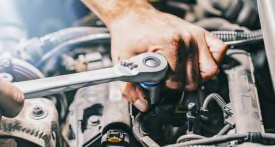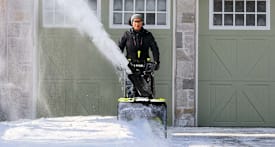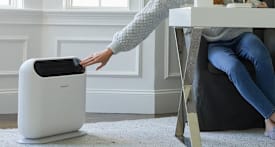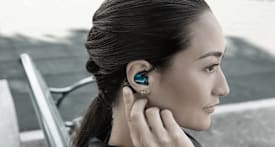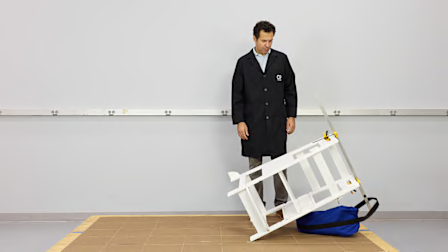Baby Walkers Have Caused Injuries and Deaths—So Why Are They Banned in Canada But Not in the U.S.?
Safety experts, including the American Academy of Pediatrics and CR, are calling for their ban. Here’s why.

When Diana Bowman created her baby registry at Buy Buy Baby while pregnant in 2018, she didn’t think twice about adding the Safety 1st Ready, Set, Walk! DX Developmental Walker. She saw it as a way for her baby to enjoy upright mobility, “sort of like ‘Hey, see how much more you can move if you are using your legs?’ ” Bowman says. “But I didn’t think it would train him to walk or really strengthen his legs enough to walk.”
Bowman says she remembered hearing something about hip dysplasia and baby walkers, so she didn’t put her son in it for extended periods of time. She also moved her couches to wall off an area in her living room without rugs, away from stairs, and away from objects that could fall on him if he bumped into them, creating a “sort of penned-in demolition derby” for him to roll around. “I’d never let him use it in or near my kitchen, or outdoors, or anywhere that he could have gone near stairs, open flames, or sharp objects,” she says.
Baby walkers have been linked to head and neck injuries, burns, and drownings. Video: Getty Images
Why Are Baby Walkers Dangerous?
From 2004 through 2008, the Consumer Product Safety Commission (CPSC) staff estimate there was an average of 3,000 injuries per year related to infant walkers among children under the age of 15 months that were treated in hospital emergency departments. The most common injuries included babies falling out of their walkers or down the stairs, injured heads and faces, contusions and/or abrasions, and injuries to internal organs.
The CPSC also reported eight fatal incidents from 2004 to 2008, one of which appeared to involve a fall from stairs by a child in a walker that didn’t conform to ASTM International standards. According to the AAP, other risks associated with baby walkers include drowning in a bathtub or pool while in a fast-moving walker and being burned or poisoned because reaching high objects is easier in a walker.
In response to the growing number of injuries, the CPSC issued a rule for baby walkers in 2010 that made some ASTM safety standards from 2007 mandatory. Those standards were intended to help prevent stair falls and tip-overs, and to ensure that children were fully supported and their legs couldn’t become trapped. The rules were updated again in 2022 to further address the risk of stair falls.
Applying multiple rounds of increasingly strict standards seems to have worked—but only up to a point. According to the CPSC’s 2024 nursery products report, the National Electronic Injury Surveillance System (NEISS) reported an estimated annual average of 2,467 injuries to children under age 5 in baby walkers, jumpers, or exercisers between 2021 and 2023 that were treated in emergency departments. (This newer data groups baby walkers with stationary jumpers and exercisers.)
According to MRI Simmons, a market research company, 351,000 fewer baby walkers were sold to consumers in 2023 than in 2013. Given this data, the number of injuries is just as significant—and the AAP, as well as advocacy groups like Kids in Danger, say walkers are never safe to use and safety regulations fall short.
James Dodington, MD, a pediatric emergency medicine doctor and an executive committee member of the Council on Injury, Violence and Poison Prevention at the AAP, says he had seen many children injured by walkers, including hand-me-down devices that may have been manufactured before the CPSC’s 2010 rule.
“Maybe we’re not seeing as much of the fall down the stairs, but the risks are numerous and the AAP would point out that they aren’t just about the fall risk, but there’s also other dangers and risks that come from them,” Dodington says. There are high risks of injury to the head and neck in walkers, he says, as well as burns from accessing a hot stove or being rolled inadvertently into a pool or body of water.
“One thing that’s really not well understood, I think by the public in general, is just how fast infants can travel in these walkers—multiple feet per second,” Dodington says.
Even with multiple rounds of increasingly strict standards to make baby walkers safer, they continue to present serious safety concerns. In 2014, about 3,600 BebeLove Baby Walkers were recalled because they could fit through a standard doorway (which violated updated safety standards) and posed entrapment hazards. In 2022, the CPSC recalled about 1,355 Zeno infant walkers because of fall and entrapment hazards. (Zeno is no longer in business.) Recently, in 2024, the agency warned against using Comfi Baby Infant Walkers, which were sold exclusively on Amazon, due to fall and entrapment hazards.
Despite repeated recalls, updated safety standards, and warnings from experts like the AAP, baby walkers continue to be sold all over in the U.S., and their use sends thousands of young children to emergency rooms every year. CR asked the CPSC if it would consider a ban on baby walkers given the many injuries that still occur with them. It responded with the following statement: “Staff constantly review incident data with a view toward ensuring that standards continue to address product hazards. To the extent that staff recommend additional improvements to the mandatory standard, the Commission will consider how best to act on those recommendations.”
One thing that’s really not well understood, I think by the public in general, is just how fast infants can travel in these walkers—multiple feet per second.
Pediatric emergency medicine doctor and an executive committee member of the Council on Injury, Violence and Poison Prevention at the AAP.
Why Did Canada Ban Baby Walkers?
After Health Canada’s Consumer Product Safety Program investigated reports of serious pediatric health injuries caused by falls in baby walkers, Canada banned them in April 2004. Other injury reports found that children were able to reach dangerous objects that would have been inaccessible had they not been sitting in a walker.
Between April 1990 and April 2002, there were 1,935 baby walker injuries reported among children ages 5 to 14 months, according to the Canadian Hospitals Injury Reporting and Prevention Program (CHIRPP) database. The total number of injuries may have been underrepresented, however, because it only included children seen at emergency departments of participating hospitals in the CHIRPP network, according to Health Canada. About 291 million fewer people live in Canada than in the U.S., making the number of reported baby walker injuries even more significant.
It took just three years for the Canadian government to pass a ban on baby walkers, whereas in the U.S., similar efforts have been ongoing for more than three decades. A representative from Health Canada told CR that it worked with manufacturers to create a voluntary safety standard to address the risks.
“The process to ban baby walkers took approximately three years, beginning with testing of baby walkers in 2001,” Health Canada’s representative told CR. “Following this, in 2002, Health Canada completed the risk assessment and cost-benefit analysis to support the ban. During the consultation period between September 2003 and November 2003, Health Canada sent 7,298 consultation packages to a variety of stakeholders associated with children’s products, as well as healthcare professionals. A total of 270 replies were received by Health Canada and, of those received, only four opposed the proposal.”
It’s now illegal to import, advertise for sale, or sell baby walkers in Canada, including at garage sales and flea markets, and on street corners.
Despite repeated recalls, updated safety standards, and warnings from experts like the AAP, baby walkers continue to be sold everywhere in the U.S., and their use sends thousands of young children to emergency rooms every year.
Why Hasn’t the U.S. Banned Baby Walkers?
“A lot of these things are easier in Canada,” Nancy Cowles, executive director of Kids in Danger, a U.S.-based nonprofit, says. Her organization has been working since around 2000 to warn families about the risks of using baby walkers, and it has worked closely with Health Canada on these issues. “They also don’t have the same political pressure from manufacturers that we have here in the United States.”
CR reached out to the Juvenile Products Manufacturers Association (JPMA), an organization whose members represent 95 percent of the prenatal-to-preschool products in North America, with more than 50 of them participating in its certification program. We asked why JPMA doesn’t think that a ban in the U.S. is necessary and what steps the organization takes to ensure that walkers are safer.
In a statement, JPMA said it “actively participates as part of the collaborative ASTM process to continually improve the safety of products. Baby walkers on the market in the U.S. today include a number of design improvements and safety features that have made them, like all baby products, safer than at any other time. Specifically, these include:
• A larger footprint than standard doorways so a baby can’t fit through a door while in a walker and moving.
• Anti-tip/fall mechanisms engineered into the wheels and base so that if the front wheels or wheelbase goes over a top step, it will lock so it can’t tip over or down the steps.
But are current safety regulations enough? The AAP’s stance is that safety regulations fall short and that walkers should never be used.
Although calls for a federal baby walker ban have been unsuccessful so far, there are signs that some states are taking up the cause. New York State Senate Bill S111, sponsored by Sen. Kevin Thomas, a Democrat, calls for a ban on the sale of infant walkers in New York and would restrict the use of them in certain settings. In New Jersey, A831 also prohibits the sale of infant walkers within the state. Neither bill has been passed yet.
In Washington State and California, laws have been passed that prohibit child day-care facilities from using or keeping baby walkers on their premises. The New York State Child Day Care Regulations provide a more vague definition that doesn’t mention walkers by name: “Except while sleeping, awaking or going to sleep, an infant must not be left in a crib, playpen or other confined space for more than 30 minutes at any one time.”
According to Oriene Shin, CR’s policy counsel, in contrast to Canada, U.S. federal law requires the CPSC to prove that banning a product is the only option—and that no set of rules would adequately protect people. “This sets a bar so high that it is virtually impossible for the CPSC to ban a consumer product and have it hold up in court unless it’s been directed to ban the product by Congress,” Shin says.
The Dangers of Buying a Baby Walker Used or Online
And then there’s the complex challenge of how to ensure the safety of consumers purchasing secondhand baby walkers, or purchasing walkers that may not meet safety standards from third-party sellers online. Cowles reminded us that baby walkers “last forever” in the secondhand market because people get very little wear and tear on them. “I think if you go on Facebook Marketplace, you would probably see tons of them for sale,” Cowles says.
I did a quick search on Facebook Marketplace and found hundreds of sit-in baby walkers, including one $25 “vintage toddler walker” that looked as if it were designed in the 1950s.
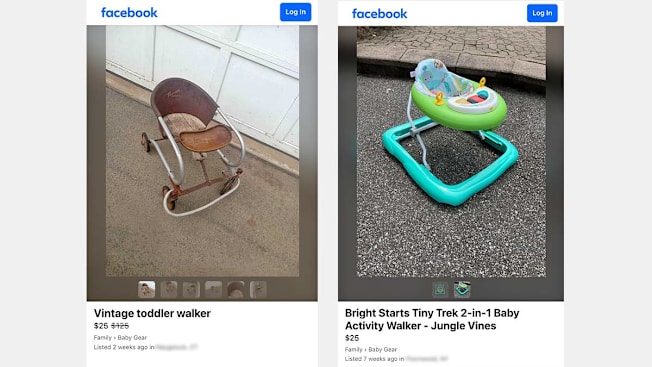
Source: Facebook Source: Facebook
“Parents and caregivers have countless options online and need to be able to trust that any baby product they buy is going to be safe,” Shin says. “It should be the rare exception—not the norm—for consumers to encounter dangerous products like old infant walkers that would fail today’s U.S. standards and are banned elsewhere. Platforms should take their responsibility much more seriously to prevent the listing of unsafe baby products and respond quickly when they learn about a hazard.”
Shin added that it’s not surprising that listings on platforms like Facebook Marketplace continue to allow the sale of secondhand infant walkers that may fail today’s standards. “For years, CR, lawmakers, and regulators have called on Facebook to step up and take stronger action on potentially dangerous products, like the recalled Fisher-Price Rock ’n Play. New parents have enough to worry about. It’s well past time for all digital platforms to take responsibility for the safety of products sold on their marketplaces.”
Baby Walkers Pose a Particular Risk for Latino Families
Hispanic consumers are almost 100 percent more likely than non-Hispanic consumers to have purchased a baby walker in the past six months, according to a 2024 Spring MRI-Simmons USA study. We aren’t sure why this is the case, but it may be a combination of factors, including family tradition and the long-standing belief that walkers help a child’s development.
When CR’s Karina Carpio was a toddler, she used a sit-in baby walker. She says she has several cousins who used one as well. “My family thinks it’s very important to provide children with lots of stimulus to help them grow and develop,” Carpio says. “I think subconsciously there’s this pressure for your child to develop quickly and efficiently. They definitely believed at the time that it would help me learn to walk quicker.”
Carpio said that her mother, who is Peruvian, has always been vigilant, and that she has rarely been in dangerous scenarios she hasn’t been able to catch and prevent. “I think it’s also important to note they believe there’s a risk with everything, and you have to exercise caution all the time anyway,” Carpio says.
CR’s Luz Plasencia spent time in her early childhood in the Dominican Republic and says she used a baby walker and saw many family members and friends that had baby walkers for their kids growing up. One time while using a walker, Plasencia fell forward because it went over a small ledge in the porch of her house.
But her family’s reasons for choosing a walker echo that of Carpio’s: “I think the belief is that it helps the babies walk sooner or strengthen their legs for walking.” Plasencia says she didn’t know the risks associated with walkers until she was having her own child 15 years ago, and she opted not to use one.
Jesica Uzueta, 36, from Arizona, told CR that she and her four siblings used baby walkers when they were babies and that her siblings went on to use them with their own children. “Family members encourage getting one around 7 months,” Uzueta says. “It’s supposed to give the baby confidence so they won’t be scared to take steps once the baby is out of the walker.”
Uzueta added that her friends and family also believed walkers strengthen a baby’s leg muscles and help ground their feet. “It is believed the baby will learn how to walk on a walker sooner than without one,” she says.
Do Baby Walkers Help Your Baby Learn to Walk Sooner?
The medical evidence doesn’t support the idea that baby walkers can help children develop stronger muscles or encourage them to take their first steps sooner. A study published in 2002 “provided additional evidence that baby walkers are associated with delay in achieving normal locomotor milestones.” According to a 2019 study, babies in the study group who used a baby walker “had lower gait velocity, greater duration of both stance and swing phases, and reduced knee amplitude in the sagittal plane. Furthermore, this group showed greater hip amplitude in the sagittal plane at gait acquisition.” A simpler explanation is that the babies who used walkers walked slower and their bodies were placed in positions that weren’t conducive to natural walking patterns.
Maral Amani, a pediatric physical therapist and child development expert at Lovevery, told CR she discourages parents from using infant walkers for several reasons:
• Because the seat of the walker supports the child’s weight, Amani says children who use them don’t learn how to fully bear the weight of their body in order to stand or walk outside of the walker.
• When a child propels a baby walker forward, they often lean forward on their toes to propel themselves instead of learning how to shift their weight back on flat feet, which is necessary for walking outside the walker.
• Walkers allow for any walking pattern, including legs crossed, toe walking, and simultaneously pushing with both legs, which aren’t conducive to independent walking outside the walker.
• Walkers limit the natural wobbliness that leads to steady independent walking because of the guardrails they provide, and they don’t allow for the necessary trunk rotation and stability that’s required for independent walking.
• Using walkers can take away from time spent cruising along furniture and crawling. The latter promotes using both sides of the body (similar to walking) and strengthens the core muscles in preparation for crawling.
“Walking is more than just leg strength; it’s about the slow building of foundational skills like cruising along surfaces, getting down from standing, squatting, crawling, and core strengthening that comes from all of these movements,” Amani says. “This is why a large baby gate/playpen that enables your child to explore safely is the best tool you can have to promote early mobility in your child.”
Baby walkers provide no substantial benefit to children and can delay walking and cause significant injuries and even death. Dodington encourages parents to keep things simple for the best outcomes. “We keep going back to basics,” he says. “There is not clearly a device in the market that’s going to make your child walk faster.”
CR Supports a U.S. Ban on Baby Walkers
CR agrees with the AAP that it’s time to ban these products in the U.S.
“The evidence is clear: Infant walkers are unsafe, and the current federal standard fails to address their well-known risks,” Shin says. “Thousands of babies continue to be injured by these products every year, and parents deserve better choices for products that support their baby’s development. Congress should ban infant walkers and help parents keep their babies safe as they grow and learn how to walk.”
CR advises parents and caregivers not to purchase or use sit-in baby walkers. The incident data and medical evidence show that they put babies at risk of serious injury and don’t provide any benefit to the baby’s development. Instead, depending on a baby’s age, parents and caregivers should look for alternatives like activity centers and push walkers and toys to keep babies entertained and safe.
@consumerreports “I turned my back for a second, and the next thing I knew I saw her fall…” As an ER doctor, @TheRealDrDarria hears so many parents start their stories this way. Accidents happen, that’s why safe environments are crucial for your baby. To help you keep babies safe—and you less stressed—tap the link in our bio or visit CR.org/drdarria for a special discounted CR membership. #babytok #babytiktok #babysafety #emergencymedicine
♬ original sound - Consumer Reports


